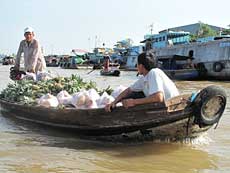Can Tho City how has an International Airport, Can Tho Bridge and the living standards and infrastructure facilities have much improved.

However, locals still preserve the typical cultural features of the wetland, of which Cai Rang Floating Market is the highlight. Vietnamese people often say ‘To know the indigenous culture, go to that land’s market as each market is the symbol of local culture’.
Getting up around 5:30 a.m. or 6 a.m. is mandatory to start a journey on the floating market on Hau River. That is the proper way to experience an authentic look into the life of the Mekong Delta, a mirror into another lifestyle that allows tourists to re-evaluate their own lives.
There is no need to rub the sleep out of your eyes, the image of hundreds of boats of all different sizes making their way to Cai Rang on the river to sell and buy farm produce and whatever products they have to offer, will wake you up perfectly. An early arrival at the thriving market ensures tourists can get a lot of souvenirs and more things to look at.
As Cai Rang is about six kilometers from the Mekong Delta city of Can Tho, a boat trip from Ninh Kieu Wharf takes about half an hour. VND200,000 for a small boat of about four people is worth the money as you drift around the corners of the 300-year-old market to see and feel the produce and merchandise, watch all the bargaining and learn how this market operates.
The market is home to fruit such as bananas, pomelos, oranges, water melons, sweet potatoes, pumpkins and other farm produce that goes to Cai Rang to sell to wholesalers. The smaller boats load up with tomatoes, vegetables, cucumbers, pork, fish, soft drinks, noodle soup and the other necessities to sell to families who live on boats.
As the sound of engine-powered boats, the conversations of local people and tourists as well as the shrill of the waves, sellers cannot raise their voices high enough to advertise their products, so the vendors tie samples of what they sell onto tall poles cry out ‘cay beo’ so that the buyers can see. The wholesalers buy in bulk and distribute the produce around the region and the country.
It is hard to leave the market without buying something edible along the way, especially in such a special place which is like dangling candy in front of a child then saying no.
Drifting around the market, you will experience the hardship of what it must be like to live this life all year round. Not boasting clear, blue water, the rivers of the Mekong Delta are a humble dark red all year round, as the build-up of alluvium from way upstream entering the delta and giving the waters here, which are shelters and a work place for residents, their special color.
The market often closes after 9 a.m. when the sun rises high. By midday, most of the floating market has dissipated but there are still a few lingering boats on the water, desperate to make a late sale. There is no separation from home and work life, as is evidenced by the clothes hung out to dry on the side of the boat and the women and children napping on the deck.